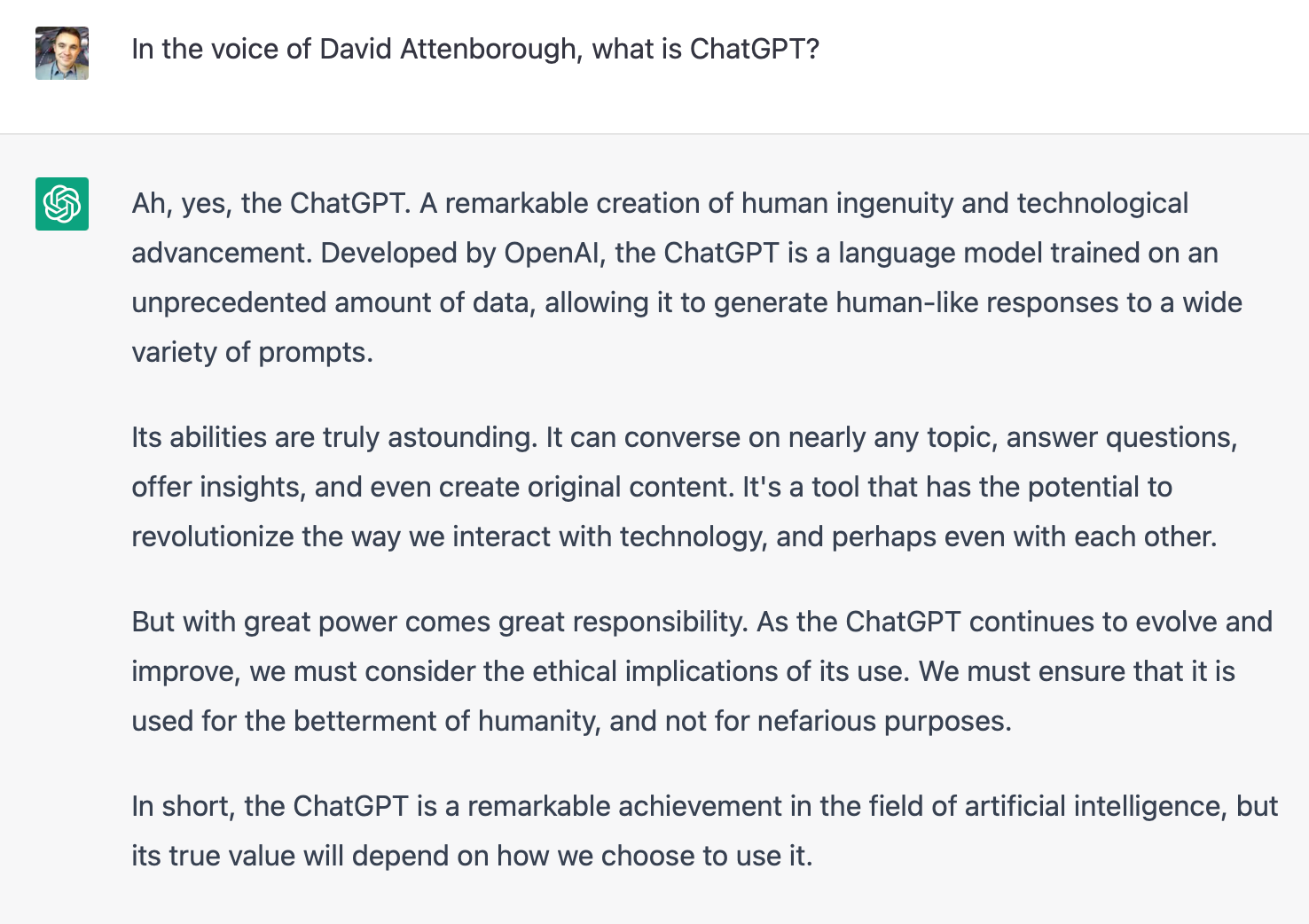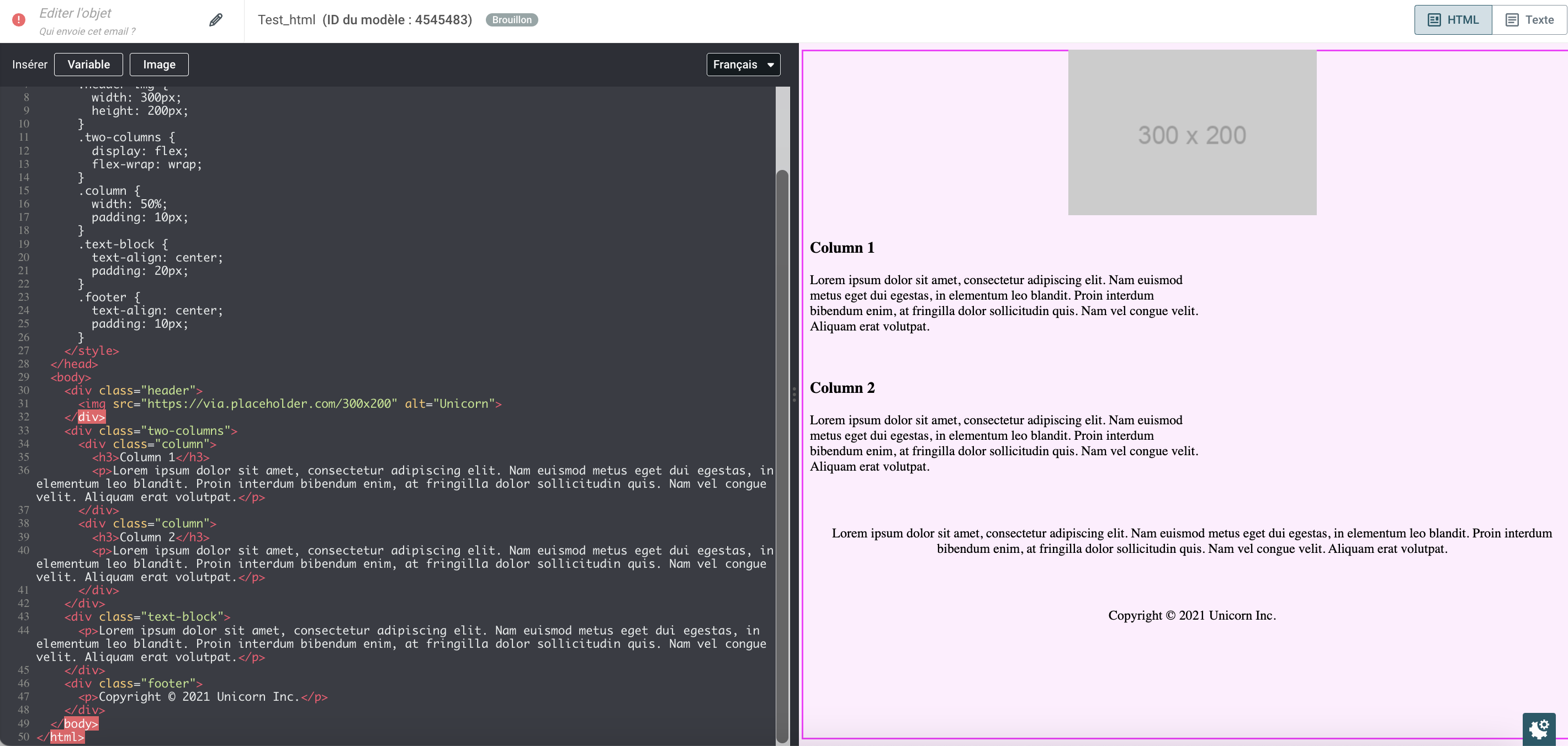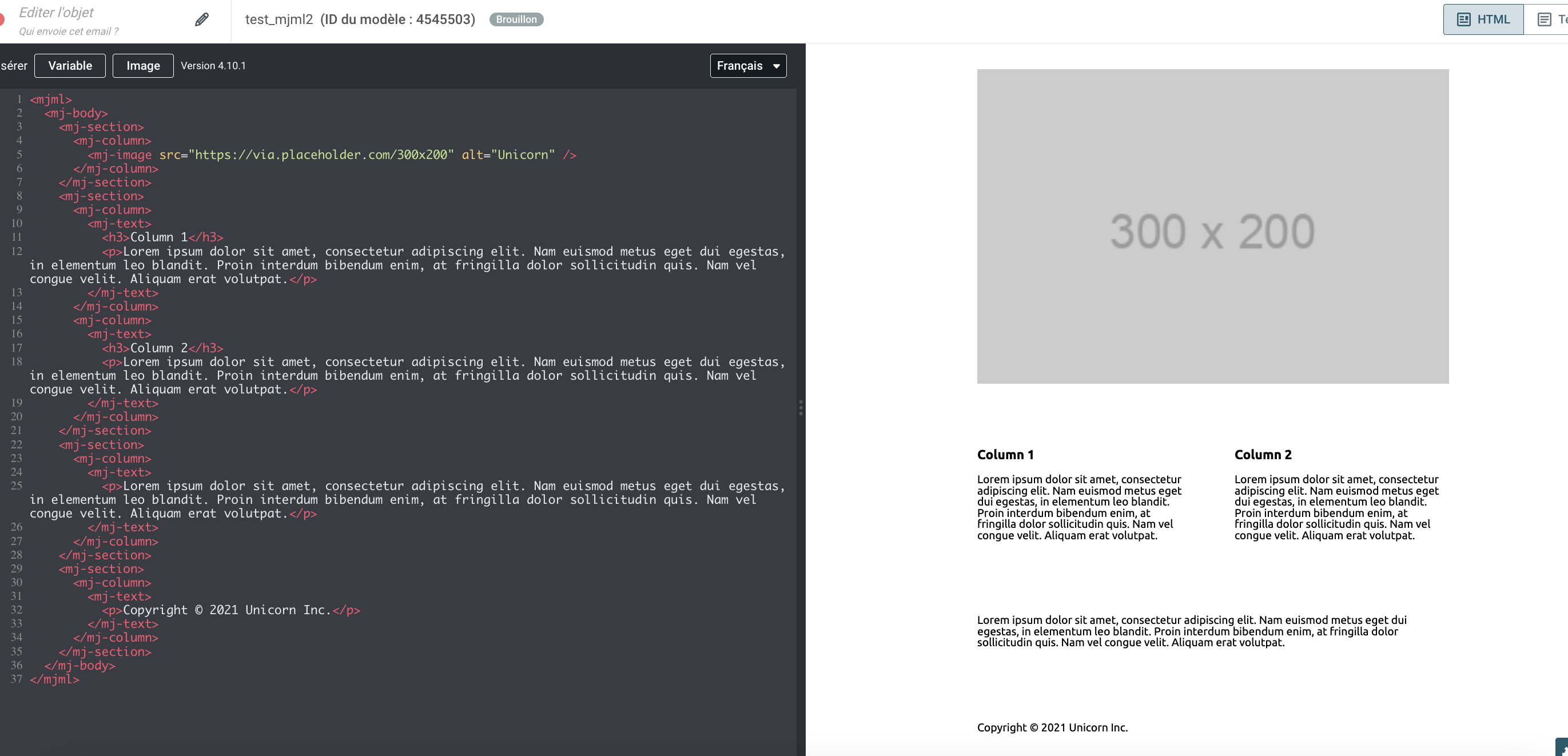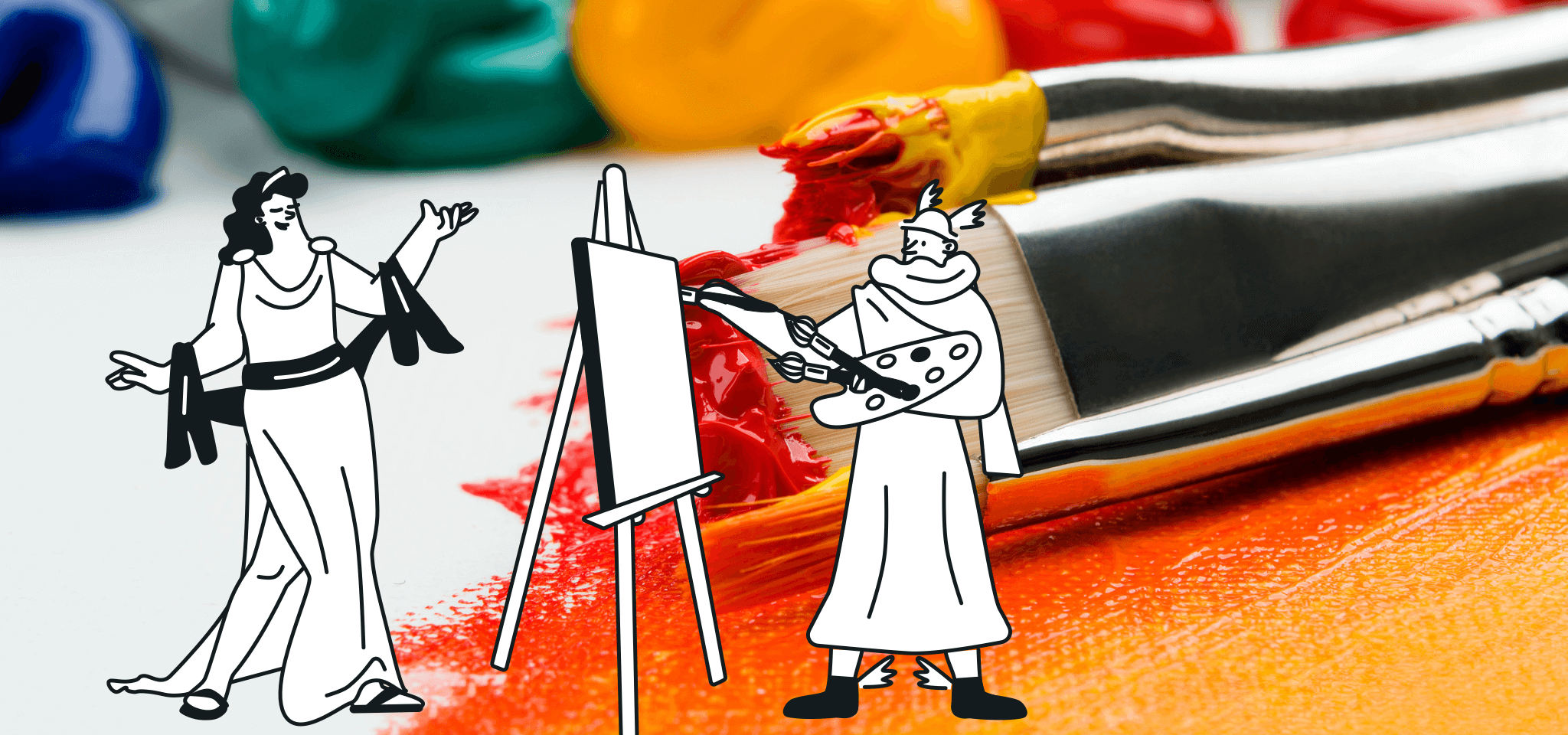Email best practices
The power and limitations of using ChatGPT for email marketing
There’s a lot of talk about ChatGPT right now, but how does it relate to email marketing? Discover AI’s practical strengths and weaknesses so you can start leveraging the tool effectively.

PUBLISHED ON
Artificial intelligence has got the whole tech scene buzzing all over again. First, it was the release of ChatGPT. Next, Microsoft, who partially funded its research company Open AI, decided to bring out a Bing AI chatbot to challenge Google’s search engine dominance. And now, Google has returned to the tech giant as the company rallies to release their own AI tools.
And like any new trend in the tech world, there’s a debate about the role this new technology plays in forming our globalized society. The question of job security and the prospect of even less human interaction has got us into an existential knot.
But here at Mailjet, we’re more interested in how AI will shape the future of email. To find out, we put HTML templates to the test, explored AI’s ability to sound like a human, and even pitched our in-house email marketer’s work against AI.
There’s a whole lot of ground to cover, so let’s get started.
Table of contents
Collaborate on compelling campaign outlines and planning
Create catchy subject lines and headlines
Multiply with other programs
HTML and MJML template generation challenges
Matching brand voice
Localization
The Mailjet Product Newsletter: Sinch Mailjet’s version
The Mailjet Product Newsletter: ChatGPT’s version
Sinch Mailjet News: We recently launched a new AI-powered writing assistant! Want to learn more? Check out our AI Copy Generator, which will help you save time and come up with amazing content for your campaigns.
What is ChatGPT?
Siri, Alexa, and Google Assistant have made their way into our lives as helpful but limited pre-programmed personal assistants. If you need to know the weather, want to a hear fresh playlist, or need something in your calendar, you can say it all hands-free.
But ChatGPT is more than just a fancy tool that plays great music or provides reminders. Developed by Open AI, ChatGPT is an AI language model that has been trained on a diverse range of internet text and can respond to a wide variety of questions and generate text on various topics and in multiple forms.
Its ability to understand humans intuitively and respond creatively has taken the world by storm. The most impressive development: ChatGPT is not limited to specific commands and tasks, but instead can create original content, code, and analysis previously only possible by humans.

For best results, read in the voice of David Attenborough.
So, there’s no wondering why ChatGPT has every marketer asking one of two questions: “Can this make my job easier?” or “Is this going to replace me?”
Well, it’s never just black and white – there are many ways AI can assist you in the day-to-day which you wouldn’t expect. For example, ChatGPT can act like Google Translate for cross-departmental communication, making it easier to collaborate and share ideas. Technical information goes in one end and simplified explanations come out the other.
We’ll see how this technology will affect the field of email marketing by separating myth from fact. The marketers at Sinch Mailjet have been busy noodling around with ChatGPT, figuring out what it realistically can and can’t do.
The power of ChatGPT in email marketing
Before computers, everything was paper based. Before the internet, there were entire careers that didn’t exist. And while change is scary and AI-powered change is even scarier, there’s no denying AI is the next major step in the tech revolution.
Why? Well, ChatGPT has the power to:
Remember everything in the conversation
Learn from feedback
Produce code in many programming languages
Understand and translate into 10 languages
Create tables of data and text
And this isn’t limited to ChatGPT. There are plenty of AI-powered tools that are already quite common in the world of marketing and email, from language assistants to send-time optimization engines.
So, how can ChatGPT streamline your email marketing process? Let’s explore the practical ways to use Open AI’s language model for good.
Collaborate on compelling campaign outlines and planning
When it comes to processing multiple sources of information and forming an email outline or structure, ChatGPT takes the cake. Sifting through information to create a structure with reader intent in mind is usually time consuming and headache inducing. But it doesn’t have to be anymore.
For example, while researching for this article, there were a lot of great points raised by our talented team during multiple discussions on Slack (who hasn’t had Slack discussions on ChatGPT these days?). It was easy to pull out all the information, open up ChatGPT, and ask the tool: Create an outline for a blog post based on the following information.
The best part? You can paste in rather incoherent ramblings and disorganized information and ChatGPT will decipher, rearrange, and structure key information into an outline. However, for ChatGPT’s output to be truly impactful to your email marketing strategy, you’ll have to specify the objectives of your campaign and define your target audience. You’ll need to be the strategic brain behind AI’s tactical execution.
ChatGPT isn’t perfect. It makes mistakes and often produces responses that don’t really meet the requester’s expectations. But it can learn. So, if the first outline isn’t what you were looking for, you ask ChatGPT to take another stab at it by just pressing “Regenerate response” until it creates something that looks closer to what you’re looking for, or you can provide it with the feedback you’d like it to incorporate in subsequential versions.
ChatGPT can also help with building a multi-email series for a specific campaign or balancing email scheduling for different communications your brand needs to send in a short period of time. That’s a common scenario for our Email Marketing Manager, Julia Ritter, and an area where she’s unexpectedly found help from ChatGPT.
“Sometimes email requires a lot of juggling. You might have multiple email communications that need to be sent out in the same week to different audiences that also overlap. I do love a puzzle, but sometimes I just don’t have the time to second-guess all my decisions and do a deep analysis on all the variables. Luckily, this seems to be something ChatGPT can help with: I gather some initial thoughts, plug the equation into ChatGPT, and see what comes out. Surprisingly, when I’ve tested it, I’ve actually agreed with the strategy it provided.”
Julia Ritter, Email Marketing Manager at Sinch Email
Create catchy subject lines and headlines
If writing subject lines were easy, there wouldn’t be a multitude of websites offering to write or optimize them for you. Something about distilling an entire email campaign down into 60 characters or less can be stress-inducing and time-consuming.
But not for an AI language learning model. ChatGPT won’t give you one subject line – it will give you a dozen in seconds. For best results, you can tell it everything about your target persona, and the style that represents your brand voice, or you can experiment with different tones of voice or styles to the test in your campaign using an A/B testing tool.
We asked ChatGPT to Provide some email subject lines for an email campaign about ChatGPT creating email subject lines. Limit the length to 60 characters. Here are the results:
Boost open rates w/ ChatGPT's lines
Craft irresistible lines w/ ChatGPT
Revolutionize email subject lines
ChatGPT: Your key to email success
Expert subject lines by ChatGPT
Dominate email marketing w/ ChatGPT
Maximize conversions w/ ChatGPT
ChatGPT: The secret to high open rates
Say goodbye to boring subject lines
Transform your email game w/ ChatGPT
Unfortunately, ChatGPT is not aware of the recent development in inbox displays and lacks knowledge of the recommended length for email subject lines, so you’ll need to be very specific with your commands to get the output you expect.
However, the very nature of short subject lines, pre-headers, and headlines makes them easy to scan through dozens of options in seconds until you find something that’s begging to be clicked. Or it can serve as inspiration in your own creative processes. Often, you’ll just need a few edits to come up with options worth testing.
Multiply with other programs
ChatGPT is so advanced that it can sometimes feel like you’re talking to another human. People on Reddit have even confessed to saying “please” and “thank you” like it has feelings – something many people already do with their household Alexas. So, it’s easy to forget that behind all the mimicking, there’s some significant number crunching going on. It is, after all, one of the most powerful computers accessible to the public.
Why is this important? Because a computer is only as good as the data you provide. If we introduce information from other marketing tools, ChatGPT will multiply its effectiveness. Instead of having to analyze data from our marketing stack, we can ask ChatGPT to weigh in.
Here are a few examples of AI multiplication that could be used in email marketing:
AI writing tools: The difference between ChatGPT and existing AI writing tools like Jasper is a live connection to the internet. Tools like Jasper can be utilized for its online research capabilities, while ChatGPT can pick up the proverbial baton and run with it.
Email marketing platforms: The secret to boosting email engagement is producing personalized content targeted towards each audience segment. ChatGPT integrates with your favorite CRMs to become another member of your team by generating personalized recommendations and email copy for specific segments of your audience.
Customer relationship management (CRM) software: There’s a lot of data contained within CRMs like Salesforce and Zoho that could be used to steer an email marketing strategy. ChatGPT can help inform decisions around personalized product recommendations, customer segmentation, and lead scoring.
Customer support transcripts: Our favorite copywriter, Lianna Patch, showed us the value of using feedback from customer support transcripts to write marketing headlines. That kind of transcript crunching would usually take days, but ChatGPT can find the needle in the haystack in seconds.
Transcription tools: Similarly, webinars are great sources of content that often get left on YouTube in video format. Use a transcription tool like Trint to transcribe the video and paste the transcription into ChatGPT. No need to sift through thousands of words – simply ask it to create an outline, notes, and quotes for your email or blog post.
This is just the beginning. With the proliferation of ChatGPT integrations or the use of connectors like Zapier, syncing OpenAI’s language model to your favorite tools will soon become much, much easier, opening a world of possibilities for marketers to parse through time-consuming tasks in no time.
The current limitations of ChatGPT in email marketing
They say where there’s light, there’s also shadow – and that is very much the case for ChatGPT too. During our testing, we found some flaws and no-go areas that should reassure those anticipating a ChatGPT-induced role termination. Because if you spend more time steering AI than doing the task yourself, it becomes totally self-defeating. After all, we want ChatGPT to save us time, not have us tearing out our hair in frustration. In the end, if we can do the job faster or to a higher quality ourselves, then we’d rather pass for the time being.
Right now, Open AI’s language model is limited to:
A 500-word input/output limit
Sources internet information up to 2021
Receiving text input (no tables)
So, how does this impact email marketers? Let’s take a look through some of the limitations we discovered while using ChatGPT for email marketing.
HTML and MJML template generation challenges
You’re probably wondering, how does a text-based program produce email templates? Well, it comes down to the basic building block of all emails – HTML. As email geeks, we were very excited to put this new technology to the test. And the results were…mixed.
We asked ChatGPT: Create an HTML email template with two columns, a unicorn image placeholder above the two columns, a block of text below the two columns, and a footer at the bottom.
Here’s the result rendered in Mailjet’s Email Editor:

Hmm…off to a poor start in template development.
As you can see, ChatGPT struggled to understand and code the two-column layout. Our Mailjet Product Manager, Stephanie Watson, had to work hard to get ChatGPT to produce her desired output, and eventually it was asking ChatGPT to produce the same template using Mailjet’s bespoke email markup language, MJML, which did the trick.

That’s more like it!
Yes, based on this last example, it does seem that for the first time ever, email marketers with no programming experience can produce their own email templates. But will it be quicker than using Mailjet’s drag-and-drop builder? Probably not. Plus, if you’re not extremely specific and somewhat technical, the generation of the HTML/MJML email templates in ChatGPT is going to prove difficult for the average marketer.
The development of responsive email campaigns that are accessible to all your audience is no easy task. Megan Boshuyzen, our Sr. Email Developer at Sinch Email, shares some of the risks and challenges of using ChatGPT to produce email templates:
“While ChatGPT can be used to get the basic shell of an email coded, it does not know all the quirks and hacks needed to make email development work at a larger scale. Without excessive prompts, it doesn’t know how to code an accessible email, or properly take care of dark mode. The code has the potential to be riddled with error, inadvertently slowing down development when an email developer needs to spend time understanding and debugging the code, rather than investing time in creating other systems (like an email design system) that can speed up development.”
Megan Boshuyzen, Sr. Email Developer at Sinch Email
Matching brand voice
Not enough is said about the role of brand voice in copywriting. It separates the brilliant from the bland, the conversational from the formal, and the humans from the robots. If you were hoping ChatGPT could quickly drum up some zesty copy into your next campaign, you might be a little disappointed.
The default voice of ChatGPT is formal. So, you’re not going to stir up much engagement from your readers by just copying and pasting the output into your campaigns. If you ask ChatGPT to take something formal and “make this more conversational,” the output is going to sound like an American car salesman from the 80s.
And here lies the endless goldilocks problem with copy generated from ChatGPT. It usually starts with the voice not going far enough and then it goes too far. Or with ChatGPT not understanding the nuances of your brand identity. You’ll likely spend more time trying to get your tone of voice just right than if you just did it yourself. Plus, when the back-and-forth gets too intense, ChatGPT has the frustrating, tendency to forget previous prompts.

At Sinch Mailjet, we have an established brand voice that really shines through in our email communications. Could ChatGPT mimic it? We don’t think so.
Localization
Wouldn’t it be great if you could translate your website into every language using AI? Imagine the web traffic, sales potential, and growth a business could harness. But while it’s true ChatGPT can translate text into other languages, there are some barriers it comes up against.
The main issue is that the dataset used to train ChatGPT is over 96% English. In its language training report, Open AI says, "English is the most common language that GPT-3 was trained in, so it may have better performance for English than other languages.”
So, what other languages does ChatGPT support? Here’s the list:
English
Spanish
French
German
Italian
Portuguese
Dutch
Russian
Chinese
Korean
ChatGPT can perform competitively to machine translation like Google Translate or Deepl. But localization goes far beyond performing simple translations and most people often forget how nuanced localizing content actually is. For example, the way you communicate with German, French, or Japanese people is totally different from how you communicate in the US. If your creative campaigns are being written in English, they’ll need to be heavily localized or even transcreated, something that requires fluent speakers of both languages to nail nuances down.
Will ChatGPT replace email marketers?
If you’ve spent your entire career honing a craft, it’s understandably daunting to see AI in its infancy already so refined. So, will it take our jobs? As always, the answer is not black and white. Should we get our pitchforks out? We’d argue that by taking a step back, there’s nothing inherently good or bad about new technology, it just is.
We could stay up late speculating who would create a better email campaign – a professional or ChatGPT? That’s exactly what Sinch Mailjet’s and Action Rocket’s marketers and email developers will be discussing in a series of upcoming webinars.
But until then, we decided to conduct an experiment and ask both our team and ChatGPT to show us their best work. Curious to see what AI can do? Here are the results.
The Mailjet Product Newsletter: Sinch Mailjet’s version
There’s a reason why our subscribers look forward to seeing our newsletter. It’s carefully planned, created, and developed by the most talented email experts in the industry. It exudes our brand personality while sticking to our defined tone of voice. By using emotive language, the reading experience feels personal and human. The CTAs are light-hearted, yet instructive. The blurbs are short and sharp without missing key information. And for our pop-culture fans, there’s usually an easter egg hiding in there.

Subscribe to Mailjet’s newsletter for product updates and useful articles.
The Mailjet Product Newsletter: ChatGPT’s version
Now it’s time to see how the world’s most sophisticated AI chatbot competes against a human being. You’re probably wondering how we went about feeding ChatGPT information for our test:
Firstly, we had to feed it a recent blog article about our new Form Builder into ChatGPT.
Then, we asked, “Create an email marketing campaign about our new Form Builder for a large audience of marketers. The tone of voice should be fun and witty but professional.”
Next, we gave it the same template our email marketer uses for her email outlines.
And finally, we copied the results into the template in Mailjet’s Email Editor.
Here’s the result of our little experiment (cue drumroll).

How does an AI compare to a human?
So here it is – same design, different story. There’s no denying it: We could get away with sending this AI-generated email out to our database of professional marketers. There are no mistakes, it covers just enough of the product, and doesn’t duplicate information.
But unfortunately, “just enough” doesn’t translate to engagement in the inbox. This email, while passable, sounds like a bad sales pitch. It’s all “me, me, me” and does little to speak to the user’s pain points and needs. Plus, it doesn’t have any of the personality or wit that we asked for and doesn’t use our editorial guidelines (that use of Title Case definitely wouldn’t make the cut with our Head of Content).
So, it’s unlikely readers would connect this email to our brand and will likely fall into the noise of other emails in the inbox. Nice try though, ChatGPT.
How to work effectively with ChatGPT
By this point, it should be clear that AI isn’t evolved enough to simply do our jobs for us. There’s a saying going around that “AI won’t take your job, but the person using AI will.” So, what should smart email marketers do? Get ahead of the curve and acquaint themselves with this new tool.
Here are some tips to start working effectively with AI:
The role of human oversight, strategy, and taste: Ultimately, whatever ChatGPT produces needs to be edited and fact checked. Like shaping pottery, you will need to communicate a clear brief and then edit it to make it fit for purpose. Treat this as a collaborative effort.
Importance of technical knowledge: Knowing your product inside and out is still essential as ChatGPT is known to produce inaccurate results. Scrutinize everything it produces and don’t stop using subject matter experts to validate results.
Quantity does not equal quality: Just because ChatGPT can produce 100 emails in a fraction of the time doesn’t mean they’re worthy of sending. Our comparison earlier should be enough proof that bland emails do not translate to higher engagement.
ChatGPT is only a starting point: AI is great for getting ideas down on paper. So, if you’re having writer’s block and need help brainstorming, ChatGPT is a great place to start. But don’t get ahead of yourself – it will only produce something akin to a block of marble that needs chiseling down to something useful.
In conclusion: How useful is ChatGPT?
It’s clear by now that AI can do many things, but usually with a drawback. For the time being, the role of ChatGPT is going to be limited, but that doesn’t mean it can’t prove useful. There’s a chance for marketers to save time on some menial tasks and get the ball rolling on others. But on the whole, there’s a huge amount of oversight necessary and, in some cases, it would be quicker to just do it yourself.
So, let’s recap the benefits and limitations currently facing ChatGPT:
It can crunch data and produce succinct outlines
It can generate dozens of eye-catching subject lines
It’s limited when it comes to creating responsive, accessible, and impactful HTML email templates
It struggles to match a brand’s tone of voice
It can translate to other languages but not localize or transcreate to really speak to a local audience
It can produce basic copy but nothing close to a real human
As ChatGPT can do a lot of things at a basic level, it’s likely that inboxes (and the internet) will soon be full of average content and replication. The bar for standing out in the inbox is going to raise very quickly, and the true creatives and strategists in our field will prosper.
If that sounds a little daunting – relax, we’ve got you covered. Mailjet’s blog and newsletters revolve around something AI can’t empathize with – fostering relationships with your customer. While AI can be a great starting point, our best practices will help you expand, develop, and customize your email strategy to beat the competition.








